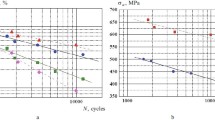Abstract
Fatigue crack propagation (FCP) experiments were conducted on beta Ti-15-3 alloy under various loading conditions to examine the constancy of the specific enthalpy for fracture, advanced by the Crack Layer (CL) theory as a material parameter characteristic of its intrinsic toughness. The energy release rate and the irreversible work were determined from load-displacement curves during crack propagation. Microscopic and diffraction analyses were conducted to identify the damage mechanisms ahead of the crack tip. A damage zone whose geometry exhibited plane strain character at the initial stage of crack propagation was observed optically. The damage zone transformed into plane stress configuration when the crack reached half its critical length. Damage mechanisms involved slip lines and microcracking which is believed to ensue from intense accumulation of slip processes. The magnitude of microcracking became more weighty as the crack moved deeper into plane stress dominance. The damage preceding crack advance was quantitatively assessed as the ‘crack resistance moment’ which is the volume of transformed material per unit crack extension. Application of the CL theory to the data generated under a wide range of applied stress levels gave rise to a constant value of the specific enthalpy of fracture, 20 MJ/m3. This value is in close agreement with the specific energy of slip lines computed from microstructural considerations.
Similar content being viewed by others
References
ASTM Standard E399-74, Annual Book of ASTM Standards, Part 10 (1976) 432.
ASTM Standard E813-81, Annual Book of ASTM Standards (1982) 822.
British Standard Institution BS5762, BSI London (1979).
G. Irwin, Journal of Basic Engineering, ASME 82 (1960) 417.
W. Andrews, W. Kumar and M. Little, ASTM STP 743 (1981) 576.
H.P. Keller and D. Munz, ASTM STP 613 (1977) 217.
M. Lai and W. Ferguson, Engineering Fracture Mechanics 13 (1980) 285.
C. Nils and S. Jorg, Communications of American Ceramics Society 59, Nos. 9–10 (1976).
S. Hashmi and J. Williams, Journal of Materials Science 19 (1984) 3746.
J. Hodkinson and J. Williams, Journal of Material Science 16 (1981) 50.
J. Williams and M. Parvin, Journal of Materials Science 10 (1975) 1883.
H. Brown and I. Ward, Journal of Materials Science 8 (1973) 1365.
J. Kaufman and R. Kesely, ASTM STP (1975) 138.
D. Read and R. Reed, International Journal of Fracture 13 (1977) 201–213.
S. Putatunda and S. Banerjef, Engineering Fracture Mechanics 19, No. 3 (1984) 507.
J.R. Rice, Journal of the Mechanics and Physics of Solids 26 (1978) 61.
A. Chudnovsky, Crack Layer Theory, NASA Contractor Report #174134 (1984).
A. Chudnovsky and A. Moet, Journal of Materials Science 20 (1985) 630.
I. Mostafa, G. Welsch and A. Moet, Journal of Materials Science 26 (1991) 2615.
I. Mostafa, G. Welsch, A. Moet and A. Chudnovsky, Materials Science and Engineering A111 (1989) 85.
J. Begely and J. Landes, Fracture Toughness, ASTM STP 514 (1972) 1.
Author information
Authors and Affiliations
Rights and permissions
About this article
Cite this article
Mostafa, I., Welsch, G. & Moet, A. The specific enthalpy of fracture for beta Ti-15-3 alloy. Int J Fract 58, 361–373 (1992). https://doi.org/10.1007/BF00048955
Received:
Accepted:
Issue Date:
DOI: https://doi.org/10.1007/BF00048955




